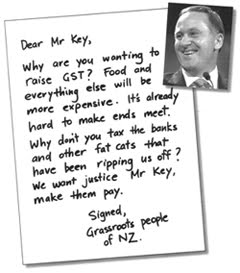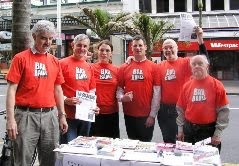International credit rating agency Standard & Poor says that all Australian banks have "insufficient funds to cover their lending exposures", reports the Sydney Morning Herald on 25 November 2009.
No Australian banks were included in the handful that Standard & Poor believe meet the minimum threshold to be considered safe for depositors.
Given that Australian banks own all major New Zealand banks, this news is hugely significant for the Bad Banks campaign in Aotearoa.
The Standard & Poor analysis points towards the financial unsoundness of Australian-owned banks in New Zealand. See Australian banks fail new capital test.
Australian banks fail new capital test
by Eric Johnston
Sydney Morning Herald
25 November 2009
RATINGS agency Standard & Poor's has warned that nearly all the world's big banks - including Australia's major lenders - have insufficient funds to cover their lending exposures and risk a ratings downgrade unless they move to bolster their balance sheets over the next 18 months.
The warning follows the release of a tougher global measure of bank capital by Standard & Poor's, which has found that most large banks do not meet the minimum 8 per cent threshold under the credit ratings agency's new risk-adjusted capital ratio.
The findings appear to be out of step with claims by Australian banks that they are among the strongest in the world under the traditional measure of bank capital known as the tier 1 ratio.
Over the past year, Australian banks have raised more than $20 billion in new capital to strengthen their balance sheets. This has resulted in an increase in the average tier 1 ratio of the big four banks to 8.9 per cent from 7.8 per cent a year ago.
But critics warn that these measures of tier 1 can be misleading because they fail to distinguish between higher-risk and lower-risk forms of lending. As well, the tier 1 measure is not consistently calculated on an international level.
Australian banks argue that their capital ratios would increase by about 2 per cent on average if they were calculated under existing British rules.
Under the new measure, S&P gives a lower rating to hybrid capital because it behaves more like debt than equity. For Australian banks, hybrid securities can make up to a quarter of their total capital. Specific exposures including trading desks and private equity would require banks to significantly increase the level of capital.
S&P reviewed 45 banks around the world under its new risk-adjusted measure. No Australian banks were included in the handful that hit the minimum threshold to be considered safe.
Of three local lenders included in the review, ANZ scored the highest rating with 7.1 per cent. National Australia Bank was at 6.9 per cent and Commonwealth Bank at 6.3 per cent.
While Australian banks benefited from having a large exposure to low-risk residential mortgages, S&P said a narrow geographic and business base counted as a negative. It also noted that the capital raisings by the local banks had been used mainly to fund acquisitions or balance sheet growth.
Among the global banks considered most vulnerable are Mizuho Financial (2 per cent), Citigroup (2.1), UBS (2.2) and Sumitomo Mitsui (3.5). The global average came in at 6.7 per cent.
''The results to date appear to confirm our view that capital is a rating weakness for a majority of banks in our sample,'' S&P said.
The ratings agency said it expected banks to continue strengthening their capital ratios over the next 18 months to comply with tougher regulatory standards. ''Failure to achieve this could put renewed pressure on ratings,'' it said.
The top-rated global bank is HSBC on 9.2 per cent, followed by Dexia on 9 per cent and ING on 8.9 per cent.
The review of capital strength comes as Australian banks face a crackdown on rules related to liquidity.





No comments:
Post a Comment